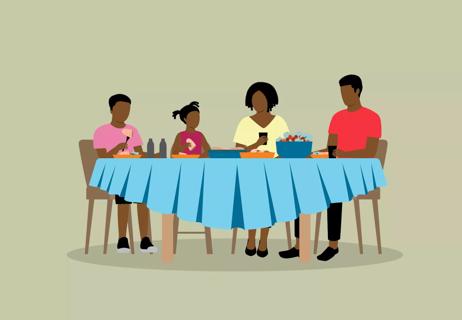The five major food groups offer different types of nutrients in the right proportions

As a parent or caregiver, one of your goals is to make sure your children are eating healthily. But what foods should kids really be eating? And in what amounts?
Advertisement
Cleveland Clinic is a non-profit academic medical center. Advertising on our site helps support our mission. We do not endorse non-Cleveland Clinic products or services. Policy
“What we eat is foundational for our bodies,” says pediatric cardiologist Christina Fink, MD. “Kids’ health depends on eating the right types of food in the right proportions.”
She joins pediatric dietitian Diana Schnee, MS, RD, CSP, LD, to talk about nutritional guidelines, including serving sizes and portion sizes, for kids in all age groups.
“The five major food groups offer different types of nutrients,” Dr. Fink explains, “and kids need them in the proper proportions.”
Fink says that if you emphasize a balanced plate, you won’t need to keep such a strict focus on the number of servings of each food group. “Try to focus on serving balanced meals and snacks throughout the day,” she says.
But what does that mean, exactly? A balanced plate, as modeled by the U.S. Department of Agriculture’s MyPlate tool, is made up of:
You can use the MyPlate to get more personalized recommendations for your child. But here’s a general breakdown of how much of each food children should each day and suggested portion sizes for kids in each age group.
“Eat your veggies” has long been a refrain of parents everywhere, and for good reason. “Half of your child’s plate should be vegetables and fruits, which gives them critical nutrients, minerals and vitamins,” Schnee says.
Advertisement
Here’s how much veggies your kids should be consuming each day:
If your kids don’t seem to be big veggie fans, experiment with types, textures and preparations to find their faves. Use MyPlate to figure out what counts as 1 cup of veggies (for example, two medium carrots, one large sweet potato, two stalks of celery, etc.).
Together, fruit and veggies should make up about half of your child’s plate. Here’s how much fruit they should eat each day overall:
Again, MyPlate explains how much of each fruit counts as 1 cup (for example, one large banana, 22 grapes, a small wedge of watermelon, etc.).
Fruit also satisfies a sweet tooth without providing any added sugar. And speaking of added sugar, be wary of fruit juice, which is often loaded with it. Kids (and adults!) should stick with 100% fruit juice — and even then, keep kids’ intake minimal.
“Juice tastes good, but it’s basically just sugar,” Dr. Fink cautions. “You get more nutrition out of eating the fruit directly. Really, kids should mostly be drinking milk and water.”
“Grains provide carbohydrates and starches, which kids need for proper growth and development,” Schnee says. Trying to pick healthy carbs for your kids? Go for whole grains instead of just white bread, which take longer for the body to process.
So, what counts as an ounce of grains? You’re looking at one regular slice of bread, half of an English muffin, a 6” flour tortilla or half a cup of rice. MyPlate shares additional serving amounts.
“Protein is one of the building molecules that your body uses to grow and develop,” Dr. Fink says. “But too much protein can put stress on kids’ livers and kidneys. They may not drink enough, which may increase their risk of dehydration — so don’t overdo it.” Fortunately, she adds that most Americans eat the right amount of protein in their diet.
Advertisement
Here’s how much protein your child should be getting:
MyPlate can help you figure out what counts as an ounce of various types of protein (for example, one egg, one slice of lunch meat, 1 tablespoon of nut butter, 1/2 cup of cooked beans, etc.).
And your child may need more than the amount recommended if they’re underweight, follow a vegetarian or vegan diet or have a diagnosed deficiency.
Growing kids need calcium, which they get from dairy products like milk and cheese. But as always, too much of a good thing is, well, too much. Your child should drink no more than three glasses of milk per day.
“Once they’ve already received the amount of calcium they need, drinking more milk may just take the place of other food or be a source of excess nutrition,” Schnee explains. After the toddler phase, switch your kids from whole milk to low-fat milk to reduce their overall fat intake.
Here’s the right amount of dairy for your child:
Advertisement
One cup of dairy amounts to 1/3 cup shredded cheese, a 1/2 pint container of milk or one small yogurt, for example. MyPlate lists other equivalents to help you plan your child’s meals.
No, sugar is definitely not one of the five food groups, but it’s an important topic in any discussion about nutrition.
Too much sugar plays a role in kids’ moods, activity and hyperactivity levels, and it also puts them at risk for insulin resistance, prediabetes and Type 2 diabetes. That’s why the American Academy of Pediatrics recommends that children under 2 years old don’t consume any added sugar at all, while kids 2 and older should have no more than 25 grams (or 6 teaspoons) of added sugar per day.
“You really want to avoid excess sugar,” Dr. Fink says. “Natural sugars from foods like fruit and vegetables are OK, but try to stay away from added or extra sugars. Consume those sparingly or opt for products without added sugars.”
When looking at food labels, choose foods with little to no added sugar, when possible. Added sugars are now listed separately on food labels, which makes them easy to find.
Advertisement
Serving healthy foods to your kids is an important piece of the nutrition equation. But it’s just as critical that you equip your kids with the right information to follow a healthy diet as they get older.
“Start to educate your children on making good food choices, and do your best to be a role model for them,” Schnee advises. That means:
Teaching your kids healthy eating habits now will set them up for both a healthy future and a positive relationship with food.
To hear more from Dr. Fink on this topic, listen to the Health Essentials Podcast episode, “How to Talk to Your Kids About Healthy Nutrition (And Why It’s Important).” New episodes of the Health Essentials Podcast publish every Wednesday.
Learn more about our editorial process.
Advertisement

Most kids get enough protein in a regular diet — too much can have side effects

Look for snacks that are low in sugar and high in fiber, protein and healthy fats

Kids typically get all the nutrients they need from food, but supplements can add peace of mind

Be a good role model, set family meal times and involve your kids in meal planning

How to keep kids' diets healthy while the sun heats things up

Fiber can lower blood pressure and promote healthy bowel function

Many active children don’t consume the recommended amounts

Start having sex about 72 hours before ovulation, then at least every other day during your fertile window

Attachment theory suggests that your earliest relationships shape connections throughout your life

It isn’t a recognized mental health disorder, but research shows that problematic social media use can negatively affect your mental health, self-esteem and sleep